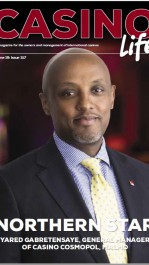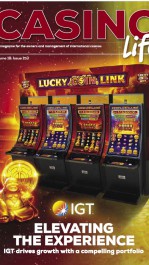How casinos can make more money with less cost. By Victor H. Royer

I happen to be old enough to remember the TV Show “Kojak”, starring Telly Savalas. In his role as Detective Theo Kojak, he made this catch-phrase world-famous. “Who Loves Ya, Baby?” became the “in” phrase of the 1970’s – at least for a while.
But what does that have to do with casinos and gambling?
It has to do with customers. The good, and the bad. And no, not the ugly, as in that famous Clint Eastwood spaghetti Western. And it applies both to the casino operators, and equipment manufacturers, particularly slot makers.
I recently came across a paper titled: “Competing on Analytics”, which is available online at this link: http://www.babsonknowledge.org/analytics.pdf
In it, the authors surveyed 32 companies, to find out how these businesses are managing in an ever-more competitive market. Not only markets increasingly dominated by competition, but also saddled with more and more governmental scrutiny, interference, and really unintelligent demands. We only need to look at the recently proposed IRS requirements that casinos report slot jackpots of $600, or more, instead of the current $1,200, to see how such inane and uniformed governmental interference in business can truly be. And how easily and quickly such misguided policies can negatively impact revenue, employment, customer retention and – oh yes – all those taxes that are now being paid to the very institution that is, yet again, trying to kill its own money supply. Just this one idiotic requirement will cost each casino operator over $500,000 per year to implement. And it will add tens of millions more in unnecessary overall costs through mountains of paperwork, forms, accounting, lawyers, lobbyists, and so on and on. And, at the same time, adding more costs to IRS operations themselves, because now they will need more tax dollars to administer this, and buy more paper and office supplies to make it work. As if the $60 billion in our annual tax dollars that they already waste each year on shuffling papers weren’t enough.
But – I digress … well, not altogether, but that soapbox rant is perhaps best left to another time.
In the matter currently at hand – the competitive analytics – there’s an increasingly more prevalent movement in business in general, and in the casino business in particular, to rely ever-more on huge amounts of data collected by the machines themselves, and by data-reporting systems already intertwined with casino operations throughout each property, as well as through the use of firms and companies and analysts who specialize in this type of data-mining. Up until recently, this information has seemingly been used primarily to determine what is working, and what is not, and then to try and fix that which isn’t working, or replace it, and try something else that “might” work in it’s place. The classic examples are, of course, slot machines. Some perform well, and others not. Some casino customers like this one, but not that one. And so on.
But why?
Well, that’s the million-dollar question, right?
So, in an attempt to answer that all-elusive “why”, this “competitive analytics” movement has gained momentum. As part of the “fuel” for this movement, it’s proponents and mathematical mystics are using some really great-sounding buzz-words. Words like: game metrics, metrics of spill and fill, reverse cannibalization, optimal customers, and lifetime value. Oooohhh, I just get all sorts of chills and thrills when reading stuff like this!
But what exactly IS all this?
Well, it sort of sounds like gobbledygook. Or the phrase Supercalifragilisticexpialidocious. Especially when said backwards – which, to date, I think only Julie Andrews can do.
My point?
Just because it’s a huge amount of data, and just because these “analytics” and “analysts” use all of those fancy words as part of this new data-metrics religion, this does not mean that it actually means something.
Confused?
OK, think of it this way –
If you’re a casino operator, who do you want to love? All of your customers the same, or some of them more? And, how do you know who loves ya, baby?
Well, according to competitive analytics, you should love some customers a lot more than others. But which ones? Well, those with “optimal” results and “highest level of lifetime value.”
OK, but WHO are they? And WHY are they THIS?
You see, that’s the problem. And not just with this particular brand of analytics. It’s the same with all such data-driven policies and operational plans.
Just because you know WHAT happened, does not mean you know WHY it happened. And you certainly can’t know WHO did it, and IF they will do it again. Or when.
In the entire report which I referenced above, there’s only one gaming company that’s listed. Unless I can’t read well, and I missed the other one. That article references Harrah’s, which is now, of course, Caesars Entertainment. So, this leads me to believe that this article may not be so new after all. Maybe it’s just new to me. That’s fine. But if this kind of thinking has been part of gaming operations for a long time, then this is even worse than I thought. In that article, Gary Loveman, CEO of the then Harrah’s and later Caesars, is quoted as follows: “We use database marketing and decision-science-based analytical tools to widen the gap between us and casino operators who base their customer incentives more on intuition than evidence.”
Ummm … OK … So exactly how well did this go for you?
Caesars Entertainment drowned under almost $30 billion in debt. It’s now being broken up, it’s in Bankruptcy, there are lawsuits a-plenty, company retirees have lost their pensions, and Gary Loveman has been replaced.
So, real-good, right?
Well, perhaps not so much.
In that case, the next question should be – WHY?
Because “database marketing and decision-science-based analytical tools” is only a small part of the equation. Yes, it is important – but it’s not the Holy Grail (with apologies to Indiana Jones). There’s a lot more to this formula than just total reliance on data-dumps and related buzz-words.
In order to find which are your “optimal” customers, and how much their “lifetime value” may be, and “what attracts” them, and “why”, and “how to get them to stay and come back” – all of these answers are most definitely NOT found in “database marketing and decision-science-based analytical tools.”
It’s all actually much simpler. In fact, all those customers, and all those answers, are already there, right in front of you. And they have always been there. It’s just that they have been forgotten, over time, and the executives who now run casino operations, and slot manufacturers, simply can’t see them anymore. It’s as if all of this has suddenly become invisible.
So, how do we make it reappear again? What is this “magic” of which I speak?
Let me dive into my collection of Harry Potter movies, and see if I can snag one of these magical answers … hmmm … OK, so no casinos at Hogwarts. Must be because everyone was busy with Quidditch, and they were mostly underage at the time. Ahhh, well … so no magic wand.
But the answer isn’t magic – it’s a lot easier.
It is – the casino gamblers.
Yes, that group, which is about 20% of all your customers, but which supplies you with 80% of all your revenue.
Not the hotel rooms. Not the restaurants. Not the Nightclubs. Not the sports arenas. Not the Ferris wheels. Not the shopping malls. Not the arcades. Not the celebrity Chefs. None of this.
The most profitable customers you have don’t want any of this costly stuff. All they want is this: Good games with a reasonable chance to win; Good food cheap; good hotel rooms for a reasonable price; fast and courteous service; and a secure, comfortable, and pleasant environment – not the thumping loud music that you now use and that drives away all the customers who actually have money to spend. No one wants a headache when trying to play a slot machine, Blackjack, or Poker.
It’s all so simple.
As a casino operator, all you have to do is get rid of all those unnecessary non-gaming “attractions” and “distracting environments.” Save that money. Instead, invest in the casino. Invest in casino players, and welcome the gamblers. These are the people who will come to play, stay to play, and come back again and again to play – If you treat them right.
But, well, you see that’s the other problem.
Most of these “competitive analytics” gurus, and the casino executives who subscribe to their mantra, just don’t know how to treat gamblers. They don’t know because none of them are, or have been, gamblers. There was a time, in Las Vegas, where the casinos were run by gamblers. And people who grew up in and around gambling. And the slot manufacturers were run by people who knew what gamblers wanted, and they made it for them. But now all of the executives who have the power to change the casino business back into the gambling business – which is what it should be – themselves are either bankers, or CPA’s, or lawyers, or MBA’s, and almost to a tee they come from businesses outside of gambling and casinos. The world of “casinos” and “gambling” is as foreign to them as common sense is to Congress.
But it’s not fatal. No, not by any means.
People of this calibre, or this level of knowledge, education and expertise, are great for the casino business. They simply need to learn that they are in the Business of Gambling, and that THIS business model is unlike any other they have ever known, witnessed, or studied. This business model relies precisely on “intuition”, which is what the old-time casino owners all had, knew, and understood. It’s the intimate knowledge of what motivates and drives a gambler that makes the difference between profit and loss in the gambling business. And if you don’t have this, or don’t know it, then ask.
There are people still around who do know. Let them explain it to you, and then your eyes will be open, and you will finally see that all those analytics and data-metrics mean only paperwork, while the real profit-generating customers are already there, already in front of you – the gamblers. You just haven’t seen them before, because you’ve been blinded by all those buzz-words and mountains of “database marketing and decision-science-based analytical tools”.
And that’s the magic wand.
Just learn to look after the gamblers. That’s all you need to do. It costs very little, but makes huge profits. Throw away all those useless data-dumps. None of it will tell you why a gambler plays this game as opposed to the other. Or why they come back, or don’t. Or what makes them do what they do. All of this is information that you can only have by understanding the optimum customers you already have – the gamblers. They are a different breed. They can’t be defined – or understood – by numbers alone.
Try it yourself. Go to the casino. Play with the gamblers. Don’t say you “don’t have time.” Make time. Your job as the Big Boss isn’t to sit in your office sifting through spreadsheets. It’s to understand your customers. And to do that, you must first learn what it means to be a gambler. Once you do, casino operations and game manufacturing will suddenly seem easy – and that’s because you will now know the “why” behind the numbers, and not just the “what”.
Victor H Royer is President of Gaming Services & Research. He is a 32 year veteran of Las Vegas gaming, a 25 year consultant to the gaming industry, and author of 40 books on casino games and gaming. In addition he has researched and authored more than 300 industry reports on the subject of player preferences, marketing, player development and customer relations, and published over 4,000 articles on casino games and the casino industry. He can be reached at: DrVHR@aol.com

.gif)















